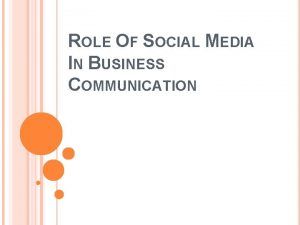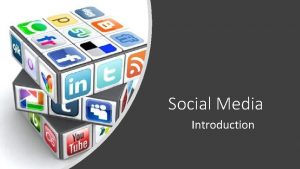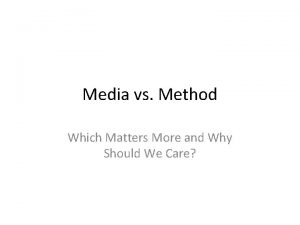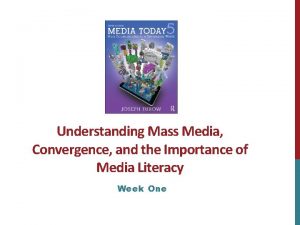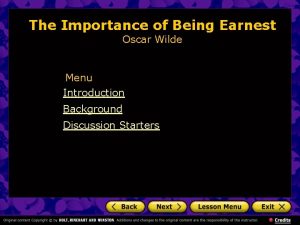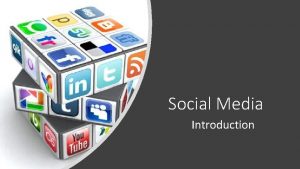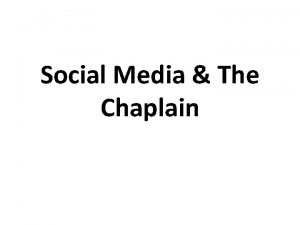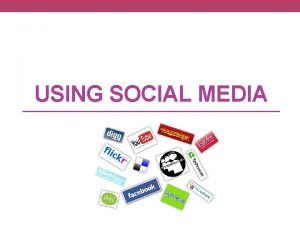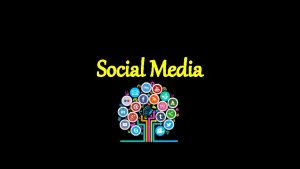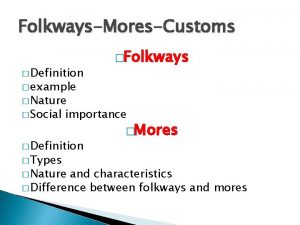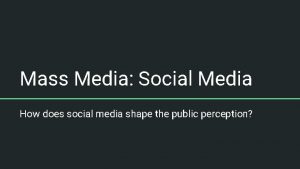Social Media Introduction Introduction Social Media Definition Importance


















- Slides: 18

Social Media Introduction

Introduction • Social Media Definition • Importance of Social Media • SMO Strategy for Business • SMO − Key Concepts • Business Profile Creation • Most popular social networks • Social media usage • Use of social media by businesses

Social media • Social Media is a platform that lets us participate in social networking. • We can share our posts on various social media platforms to improve business visibility. • Today it is the best source for news updates, marketing, education, and entertainment.

Importance of Social Media • The importance of social media is undebatable. • It is a powerful channel of marketing − a game changer for any business. • It provides us the flexibility to communicate at both personal as well as business levels. • Business owners can improve search rankings, leads, sales, and traffic using search media. This can be done at reduced marketing expenses. Besides business, it is a cool platform to connect with friends and dear ones.

SMO Strategy for Business • A wisely implemented Social Media Optimization (SMO) strategy can give a great boost to your business. • To draw maximum benefit out of Social Media, you need to set clear and well-defined business goals and objectives. The following points are the backbone of any well-laid SMO strategy: q Set measurable and achievable goals. q Know your customers. q Research over market and trends. q Explore more social networking platforms. Reflect your presence on all. q Choose core topics related to your business. q Set Social Engagement parameters. q Plan your resource use. q Track your results.

SMO − Key Concepts • Aim for building reputation by depicting yourself as a trusted source or business. • Encourage more engagement and sharing. • Be an authorized name in your industry. • Gear up originality. • Keep it social. • Master over your media platforms. • Optimize every single point that hinders your efforts.

Business Profile Creation Create an impactful Business profile. Add a well-defined persona and proficiency statement of your business. • Study competitors’ business profile, analyze their strong points, and add them to yours. • Add prominent features of your business that makes it stand out among others. • Include the milestones achieved by your company. • Add address and other details. • Include data and statistics. • List your renowned vendors. • Add some keywords to it to get noticed by the web crawler.

Brand Awareness Brand awareness is a degree to which your brand name is known. Brand name solidifies customers’ trust. So, it is important that your brand name overshadows your products. Promoting the brand name helps your business grow and get over obsolete business state. Social Media Marketing can help you in branding your business. It helps you increase your public profile as well. All you need is to: • Choose right Social Media Channel for your business. • Finalize a social content strategy. • Make a strong content strategy. • Participate in good conversation with your customers to let them feel more connected. • Keep track of all key metrics like potential reach, conversation share, links, etc.

Social Engagement • Social Media Engagement is the process of reaching out to potential customers and interacting with them through Social Media. It is primarily done in order to draw attention towards a particular product or a service. It is a two-way channel where a consumer can share a good relationship with the vendors. • To achieve optimum reach, you need to engage with your audience. • To grab more out of less, you need to strategize your social media engagement norms. q Use 'Social Channels' to reach out fans. q Use Social Media platforms to announce any event you are organizing. q Entertain Posts your audience is posting. q Use Social Media Circles to participate in valuable and educational conversations. q Participate in Social Media groups.

Most popular social networks The following list of the leading social networks shows the number of active users as of July 2018. 1 Facebook Number of Users (in Millions) 2, 186 2 You. Tube 1, 900 3 Whats. App 1, 500 4 Facebook Messenger 1, 300 5 We. Chat 1, 040 6 Instagram 1, 000 7 QQ 806 8 QZone 563 9 Tik Tok 500 Network name

Most popular social networks 11 Sina Weibo 411 12 Twitter 336 13 Reddit 330 14 Baidu Tiba 300 15 Skype 300 16 Linked. In 294 17 Viber 260 18 Snapchat 255 19 Line 203 20 Pinterest 200 21 Telegram 200 22 Tinder 100

Social media usage A survey conducted (in 2011), by Pew Internet Research, discussed in Lee Rainie and Barry Wellman's Networked – The New Social Operating System, illustrates that 'networked individuals' are engaged to a further extent regarding numbers of content creation activities and that the 'networked individuals' are increasing over a larger age span. These are some of the content creation activities that networked individuals take part in:

Social media usage • writing material, such as text or online comments, on a social networking site such as Facebook: 65% of Internet users do this • sharing digital photos: 55% • contributing rankings and reviews of products or services: 37% • creating "tags" of content, such as tagging songs by genre: 33% • posting comments on third-party websites or blogs: 26% • taking online material and remixing it into a new creation: 15% of Internet users do this with photos, video, audio, or text • creating or working on a blog: 14%

Use of social media by businesses • Although social media accessed via desktop computers offer a variety of opportunities for companies in a wide range of business sectors, mobile social media, which users can access when they are "on the go" via tablet computers or smartphones, benefit companies because of the location- and time-sensitive awareness of their users. • Mobile social media tools can be used for § marketing research, § communication, § sales promotions/discounts, § relationship development/loyalty programs.

Use of social media by businesses • Marketing research: Mobile social media applications provide companies data about offline consumer movements at a level of detail that was previously accessible to online companies only. These applications allow any business to know the exact time a customer who uses social media entered one of its locations, as well as know the social media comments made during the visit.

Use of social media by businesses • Communication: Mobile social media communication takes two forms: company-toconsumer (in which a company may establish a connection to a consumer based on its location and provide reviews about locations nearby) and user-generated content. For example, Mc. Donald's offered $5 and $10 gift-cards to 100 users randomly selected among those checking in at one of its restaurants. This promotion increased check-ins by 33% (from 2, 146 to 2, 865), resulted in over 50 articles and blog posts, and prompted several hundred thousand news feeds and Twitter messages.

Use of social media by businesses • Sales promotions and discounts: Although customers have had to use printed coupons in the past, mobile social media allows companies to tailor promotions to specific users at specific times. In other word, this special promotion was only available to people who were at a certain location at a certain time.

Use of social media by businesses • Relationship development and loyalty programs: In order to increase long-term relationships with customers, companies can develop loyalty programs that allow customers who check-in via social media regularly at a location to earn discounts.
 Role of social media in business communication
Role of social media in business communication Importance of social media
Importance of social media Two types of people media are
Two types of people media are What is social media introduction
What is social media introduction Introduction about social media
Introduction about social media Social media introduction
Social media introduction Aural language in media
Aural language in media Education media center
Education media center Introduction to media and information literacy
Introduction to media and information literacy Importance of method and media
Importance of method and media A media literate person
A media literate person Social thinking and social influence in psychology
Social thinking and social influence in psychology Social thinking social influence social relations
Social thinking social influence social relations The importance of being earnest introduction
The importance of being earnest introduction Seed pathology notes
Seed pathology notes Social media audit definition
Social media audit definition Analytical recording in social case work
Analytical recording in social case work Importance of social science
Importance of social science Importance of social interaction
Importance of social interaction
